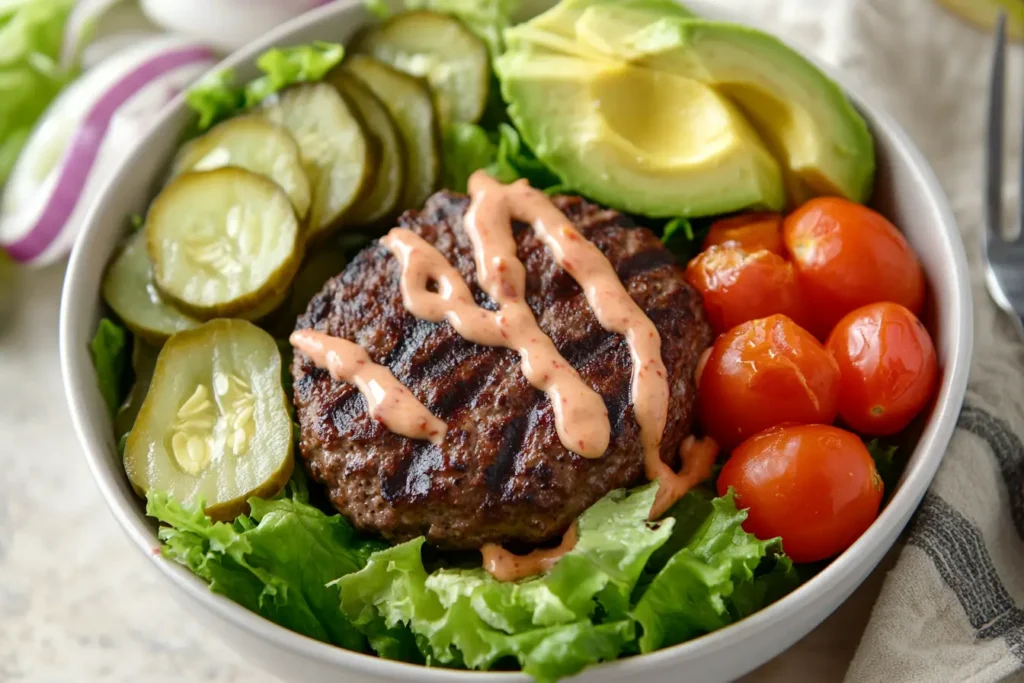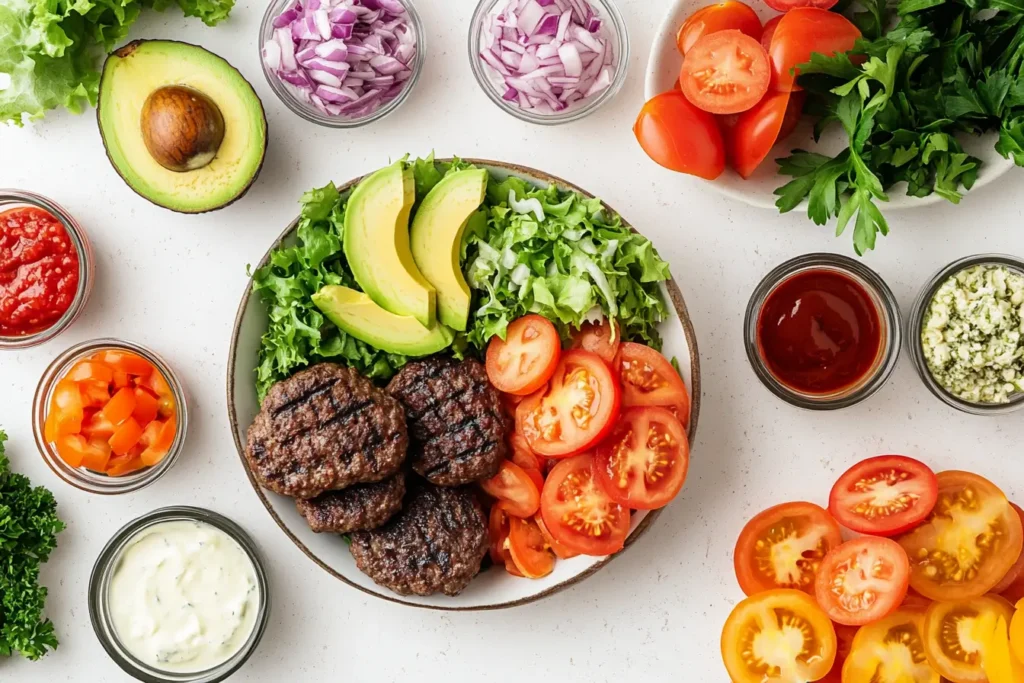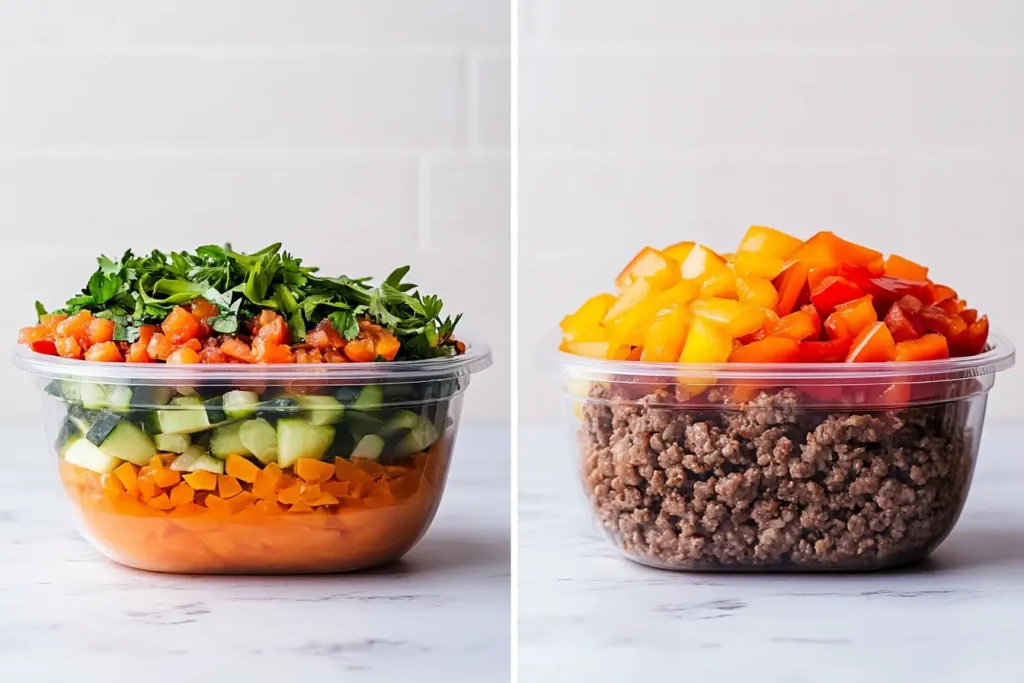How many calories are in a burger bowl? If you’re trying to eat healthier but still crave a juicy burger, a burger bowl might be the perfect solution. By ditching the bun and loading up on fresh ingredients, you can enjoy all the delicious flavors while controlling your calorie intake. But just how many calories does a burger bowl contain?
The answer depends on what goes into it. A simple bowl with lean protein and veggies can be as low as 300 calories, while a fully loaded version with cheese, bacon, and creamy sauces can exceed 700 calories. In this guide, we’ll break down the calorie count of different burger bowl ingredients, compare homemade and store-bought options, and share tips for creating a balanced, satisfying meal. Whether you’re watching your calories or just curious about nutrition, this article will help you build the perfect burger bowl!
Table of Contents
Introduction to Burger Bowls
What Are Burger Bowls?
A burger bowl is everything you love about a burger, minus the bun. Picture this: a hearty bowl filled with juicy meat, crisp lettuce, fresh veggies, and a drizzle of flavorful sauce. It’s essentially a burger reimagined into a salad or bowl-style meal.
These bowls have grown wildly popular, especially among people looking for a low-carb or keto-friendly meal. They offer the same savory satisfaction as a traditional burger but with fewer carbs and the freedom to control portions and toppings. Plus, they’re endlessly customizable!
Why Choose a Burger Bowl Over a Traditional Burger?
Why swap the classic burger for a bowl? For starters, burger bowls are more versatile. They cater to various dietary preferences, from keto to vegan, and allow for creative ingredient pairings.
Additionally, the absence of the bun reduces calories significantly. While a typical burger bun adds 150–200 calories, a burger bowl lets you enjoy the filling guilt-free. It’s a fantastic option for anyone watching their calorie intake or seeking a nutrient-rich, satisfying meal.
Burger bowls also encourage the inclusion of more vegetables, making them a colorful and nutritious addition to any meal plan. Whether you’re looking to shed some pounds or simply eat healthier, burger bowls are a fun and tasty choice!
Nutritional Breakdown of a Typical Burger Bowl
Calories in Common Burger Bowl Ingredients
When exploring how many calories are in a burger bowl, the specific ingredients play a key role. A standard burger bowl typically includes a protein base, vegetables, and a flavorful sauce.
- Protein Options: A 4-ounce beef patty contains about 280 calories, while a similar portion of ground turkey offers around 170 calories. Plant-based patties like those made with beans or soy average 150–200 calories.
- Veggies: Lettuce, tomatoes, onions, and pickles add minimal calories (10–20 per serving) while providing essential vitamins and fiber.
- Toppings: Cheese can range from 50 to 120 calories per slice, while an avocado slice adds about 50 calories.
Impact of Sauces and Dressings on Calorie Count
Sauces make or break the calorie count. A tablespoon of ranch dressing has around 73 calories, while ketchup contains 15 calories per tablespoon. Special sauces or mayonnaise-based dressings often range from 60–100 calories per serving. Choosing low-fat or sugar-free options can significantly lower the calorie total.
Side Additions and Their Nutritional Impact
Sides like fries, rice, or bread sticks can quickly add 200–400 calories. For a healthier alternative, roasted vegetables or cauliflower rice are excellent choices, keeping your meal nutrient-dense and low-calorie.
For more inspiration, you can explore this burger bowl recipe, which includes calorie-conscious ingredient ideas.
Calorie Variations in Different Types of Burger Bowls

Low-Calorie Burger Bowls
If you’re aiming for a low-calorie meal, keep things simple. A base of lean protein (like turkey or grilled chicken), fresh veggies, and a light vinaigrette dressing can create a burger bowl with under 300 calories. Avoid cheese and creamy sauces to keep it light.
High-Protein Burger Bowls
Looking for a post-workout meal? Opt for a double serving of lean meat or add boiled eggs to your burger bowl. This combo can provide over 40 grams of protein and stay within 400–500 calories.
Indulgent Burger Bowls
Sometimes, indulgence is key. Adding bacon, cheese, and a generous helping of fries turns a burger bowl into a comfort food dream, often exceeding 600 calories. While rich in flavor, these bowls are best enjoyed in moderation.
For those curious, how many calories are in a burger bowl when loaded with indulgent ingredients? A full-sized version with bacon, cheese, and fries can pack around 700 calories, depending on portion sizes.
Recipe Ideas for Balanced Burger Bowls
Simple and Healthy Recipes
Creating a balanced burger bowl doesn’t have to be complicated. Start with a base of mixed greens or spinach for a nutrient-rich foundation. Add a 4-ounce grilled chicken breast or turkey patty for lean protein, then pile on colorful vegetables like cherry tomatoes, shredded carrots, and cucumbers. Finish with a drizzle of balsamic vinaigrette for a light yet flavorful dressing. This combo keeps the calorie count under 350 and is perfect for a quick, healthy meal.
For more delicious recipes, you can explore other ideas on First Tasting’s recipe collection for creative twists on classic meals.
Customizing for Different Diets
How many calories are in a burger bowl? It depends on your dietary needs. For a keto-friendly version, skip starchy toppings like croutons or fries and use full-fat cheese and avocado. A vegan option might include plant-based patties, roasted chickpeas, and tahini dressing, with calories ranging from 300–400 per bowl.
Low-carb or high-protein? Add an extra patty or substitute grains with cauliflower rice. These tweaks can help you align your meal with your fitness or nutrition goals while keeping it delicious.
Meal Prep Tips for Burger Bowls
Burger bowls are fantastic for meal prepping. Cook and portion your protein in advance, store veggies separately to maintain freshness, and pack dressings in small containers to avoid sogginess. When it’s time to eat, simply assemble and enjoy! Preparing your ingredients ahead ensures you have a healthy, calorie-controlled meal ready whenever you need it.

Comparison of Store-Bought vs. Homemade Burger Bowls
Nutritional Differences
When it comes to the question of how many calories are in a burger bowl, the source of your meal plays a big role. Store-bought burger bowls may seem like a convenient option, but their nutritional content can vary significantly. These pre-packaged meals often include ingredients like processed dressings, higher-fat proteins, and added preservatives, which can quickly increase calorie counts.
For instance, a store-bought burger bowl might contain 500–700 calories per serving, depending on the portion size and the inclusion of calorie-dense toppings like cheese, bacon, or creamy sauces. On the other hand, a homemade burger bowl allows you to handpick every ingredient. This level of control ensures that you can choose lean proteins, fresh vegetables, and lighter dressings, keeping your bowl within a calorie range that aligns with your dietary goals—often between 300 and 500 calories.
Additionally, homemade versions are typically lower in sodium. Many store-bought meals rely on high levels of salt to enhance flavor and extend shelf life. By preparing your own burger bowl, you can use herbs, spices, and fresh ingredients to add flavor naturally.
Cost and Convenience
While store-bought burger bowls are undoubtedly convenient, they can also be costly. Depending on the brand and serving size, a single bowl might cost anywhere from $8 to $12. If you frequently rely on these meals, the expense adds up quickly. Homemade burger bowls, on the other hand, are far more budget-friendly. By purchasing ingredients in bulk, you can prepare several meals at a fraction of the cost of store-bought options.
That said, the trade-off for homemade burger bowls is time. Prepping your ingredients—cooking protein, chopping vegetables, and mixing dressings—requires effort, especially if you’re juggling a busy schedule. However, meal prepping can mitigate this challenge. By dedicating a few hours to batch-cooking your ingredients at the start of the week, you’ll have ready-to-assemble components for quick meals. This approach saves time in the long run and ensures you always have a healthy option on hand.
Taste and Customization
Store-bought burger bowls often lack the personalized touch that makes homemade meals special. These pre-made meals come with fixed ingredients, leaving little room for customization. While they may be tasty, they rarely cater to specific dietary preferences or flavor profiles.
Homemade burger bowls, however, allow for endless creativity. Want to go Mediterranean? Add hummus, olives, and a sprinkle of feta cheese. Craving something spicy? Toss in pickled jalapeños and a drizzle of sriracha. The ability to adjust flavors, portions, and toppings ensures your meal perfectly suits your taste and nutritional needs. For instance, if you’re watching your calorie intake, you can swap out heavier dressings for lighter vinaigrettes or skip calorie-dense toppings like croutons.
Additionally, the freshness of homemade burger bowls is unmatched. You have the freedom to use the freshest vegetables, premium cuts of protein, and homemade sauces, which can elevate the overall flavor and nutritional value of your meal.
Long-Term Benefits of Homemade Burger Bowls
Choosing to make your burger bowls at home isn’t just about short-term benefits like saving money or controlling calories—it’s also an investment in your long-term health. The habit of preparing meals at home encourages mindful eating, better portion control, and the inclusion of whole, unprocessed ingredients. It’s a great way to stay consistent with your dietary goals while enjoying meals that are satisfying and flavorful.
Moreover, cooking at home allows you to experiment and develop a deeper understanding of nutrition. This knowledge can empower you to make healthier choices in other areas of your diet, ultimately leading to improved overall well-being.
Final Thoughts on the Comparison
While store-bought burger bowls may win on convenience, homemade options offer superior nutritional control, cost-effectiveness, and customization. For those wondering how many calories are in a burger bowl, the answer depends largely on whether you prepare it yourself. Homemade bowls give you the freedom to keep calories in check while enjoying a meal tailored to your preferences.
If you’re ready to take your meal game to the next level, why not start crafting your burger bowls at home? They’re easy, delicious, and perfect for meal prepping. For more ideas and recipes, visit First Tasting’s recipe section and explore creative ways to make every meal a culinary delight!

FAQs
Are Burger Bowls Healthier Than Regular Burgers?
Yes, burger bowls are often healthier because they skip the bun and focus on nutrient-rich ingredients like vegetables and lean proteins. This switch not only reduces carbs but also allows for greater customization, helping you meet your dietary needs. Wondering how many calories are in a burger bowl? A standard bowl ranges from 300–600 calories, depending on toppings and portions.
What Are the Best Toppings for a Low-Calorie Burger Bowl?
Low-calorie toppings include fresh greens, diced tomatoes, cucumbers, and pickles. Add flavorful herbs like cilantro or parsley for a burst of taste without extra calories. Avoid high-calorie sauces and opt for lighter dressings like vinaigrettes.
How Can I Reduce the Calories in My Burger Bowl?
To cut calories, use lean proteins such as grilled chicken or turkey instead of fattier meats. Choose fresh veggies as the base and skip cheese or high-fat sauces. Swapping mayonnaise-based dressings for mustard or salsa can also make a big difference.
Can I Include Grains or Rice in My Burger Bowl?
Absolutely! Adding grains like quinoa or brown rice boosts fiber and makes the bowl more filling. Just keep an eye on portions to avoid adding too many calories. A quarter cup of cooked quinoa, for instance, adds about 57 calories.
Conclusion
Burger bowls offer a satisfying, nutritious twist on the classic burger experience. They combine all the mouthwatering flavors of a burger with the added flexibility to adapt ingredients to fit your dietary preferences. By skipping the bun and focusing on fresh, wholesome toppings, burger bowls strike the perfect balance between indulgence and health. For those curious about how many calories are in a burger bowl, the answer can range widely depending on the ingredients you choose.
Why Burger Bowls Are a Game-Changer
One of the biggest advantages of burger bowls is their adaptability. Whether you’re following a low-carb, keto, or plant-based diet, you can easily customize a burger bowl to fit your nutritional goals. They’re not just versatile in ingredients but also in portion sizes. Want a light lunch? Stick to a single protein serving and lots of veggies. Looking for a hearty dinner? Add a second patty, extra toppings, or even some grains like quinoa or brown rice to boost satiety.
Moreover, burger bowls are an excellent way to experiment with flavors and cuisines. Swap out traditional burger toppings for Mediterranean-inspired ingredients like olives, feta, and tzatziki, or give it a spicy kick with jalapeños, pepper jack cheese, and chipotle sauce.
Practical Tips for Perfect Burger Bowls
Creating the perfect burger bowl starts with a solid base. Greens like spinach, kale, or arugula make a nutrient-dense foundation. Add a lean protein, such as grilled chicken, turkey, or a plant-based patty, for essential protein without excessive calories. For those aiming to keep their bowl light, avoid calorie-dense additions like fried onions or large amounts of cheese.
Instead, focus on flavorful yet low-calorie ingredients. Fresh herbs like basil, parsley, or cilantro can elevate the flavor without adding to the calorie count. A squeeze of lemon or a splash of balsamic vinegar can also bring freshness and zest to the dish. And when it comes to sauces, homemade dressings made with Greek yogurt or mustard-based blends are fantastic for cutting down on added sugars and fats.
Homemade vs. Store-Bought: A Recap
If you’re considering whether to buy pre-made burger bowls or make them at home, think about the trade-offs. Homemade burger bowls give you complete control over the ingredients, meaning you can monitor exactly how many calories are in your burger bowl. This is particularly important for those following strict diets or managing their caloric intake. Pre-made options, while convenient, may contain hidden fats, sugars, and preservatives.
Additionally, cooking at home allows you to prepare in bulk, making burger bowls a practical option for meal prepping. You can store the individual components separately, ensuring they stay fresh and easy to assemble throughout the week.
A Final Note on Calorie Management
When crafting burger bowls, calorie-conscious choices can make a big difference. Opt for low-calorie, nutrient-packed vegetables as the primary ingredients. Choose lean meats or plant-based proteins to keep the bowl satisfying but light. Remember, even small changes like using a low-calorie dressing or halving your cheese portion can help reduce the calorie total.
In summary, burger bowls are a delicious, customizable, and healthy alternative to traditional burgers. They fit seamlessly into various lifestyles and diets, proving that eating well doesn’t have to mean sacrificing flavor or satisfaction. Now that you know how versatile they can be, why not try building your own perfect burger bowl at home?
For more inspiring ideas and tips on creating healthy, balanced meals, check out the First Tasting recipe collection. It’s time to reimagine burgers—one bowl at a time!
Dernière mise à jour : 10 February 2025

